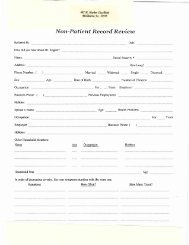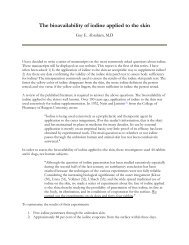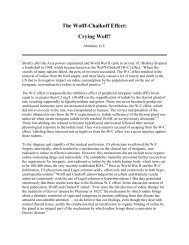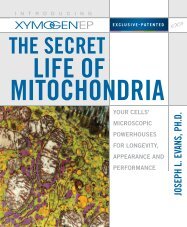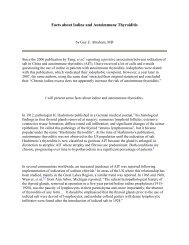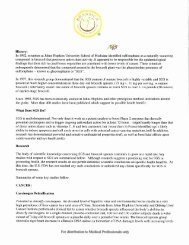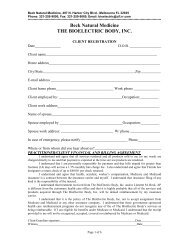Subcutaneous and visceral adipose tissue - Beck Natural Medicine ...
Subcutaneous and visceral adipose tissue - Beck Natural Medicine ...
Subcutaneous and visceral adipose tissue - Beck Natural Medicine ...
Create successful ePaper yourself
Turn your PDF publications into a flip-book with our unique Google optimized e-Paper software.
14 <strong>Subcutaneous</strong> <strong>and</strong> <strong>visceral</strong> <strong>adipose</strong> <strong>tissue</strong> M. M. Ibrahim obesity reviews<br />
regulation of PAI-1 production by human <strong>adipose</strong> <strong>tissue</strong><br />
(28). Adiponectin has been shown to inhibit the TNF-ainduced<br />
changes in monocyte adhesion molecule expression<br />
<strong>and</strong> in the endothelial inflammatory response (29).<br />
Interlukins <strong>and</strong> TNF-a are potent inhibitors of adiponectin<br />
expression <strong>and</strong> secretion in human white <strong>adipose</strong> <strong>tissue</strong><br />
(30).<br />
There are differences between VAT <strong>and</strong> SCAT regarding<br />
the capacity to synthesize <strong>and</strong> release adipokines.<br />
Leptin. Leptin expression <strong>and</strong> levels increase as the size of<br />
<strong>adipose</strong> <strong>tissue</strong> TG stores increase (24,26). <strong>Subcutaneous</strong> fat<br />
depot is the major source of leptin (7).<br />
Adiponectin. Adiponectin is expressed more in VAT<br />
than SCAT (5,31). There is significant negative correlation<br />
between body weight <strong>and</strong> plasma adiponectin level.<br />
Pro-inflammatory cytokines – TNF-a, CRP <strong>and</strong> IL-6. VAT<br />
is more infiltrated with inflammatory cells <strong>and</strong> is more<br />
capable of generating those proteins than SCAT (4,32,33).<br />
Abdominal obesity increases levels of inflammatory<br />
markers. CRP levels were significantly related to waist<br />
circumference (WC) <strong>and</strong> VAT (34,35). Compared with<br />
SCAT, VAT was more highly associated with monocyte<br />
chemoattract protein-1 (35).<br />
Angiotensinogen. Adipose <strong>tissue</strong> constitutes the most<br />
important source of angiotensinogen after the liver (7).<br />
Angiotensinogen is expressed more in VAT than SCAT<br />
(36,37).<br />
Plasminogen activator inhibitors-1. In obesity, PAI-1 levels<br />
are increased. PAI-1 is expressed more in VAT than SCAT.<br />
Omental <strong>adipose</strong> <strong>tissue</strong> secretes PAI-1 than does SCAT<br />
(38).<br />
Physiological <strong>and</strong> metabolic differences<br />
Insulin resistance<br />
Adipocytes from VAT are more insulin-resistant than SCAT<br />
adipocytes (39,40). Smaller adipocytes tend to be more<br />
insulin-sensitive; large adipocytes become insulin-resistant<br />
(41,42). Amount of <strong>visceral</strong> fat is an important factor associated<br />
with variations in insulin sensitivity (10,11,43).<br />
Insulin resistance prevents glucose <strong>and</strong> more fat from<br />
entering the cell <strong>and</strong> becoming preferentially oxidized. Subjects<br />
with <strong>visceral</strong> abdominal obesity, when compared with<br />
those with peripheral obesity, had lower glucose disposal,<br />
glucose oxidation <strong>and</strong> greater lipid oxidation.<br />
Insulin resistance may be one of the most important<br />
factors linking abdominal <strong>visceral</strong> adiposity to cardiovascular<br />
risk.<br />
Figure 1 Adverse effects of increased lipolysis <strong>and</strong> FFA mobilization.<br />
FFAs, free fatty acids; TG, triglyceride.<br />
Rate of lipolysis – free fatty acids <strong>and</strong><br />
glycerol release<br />
Visceral adipocytes are more metabolically active <strong>and</strong> have<br />
a greater lipolytic activity than SCAT adipocytes (44,45).<br />
VAT is more susceptible to the catecholamine-induced<br />
lipolysis <strong>and</strong> less to the anti-lipolytic action of insulin.<br />
Free fatty acids induce insulin resistance. In the liver,<br />
insulin inhibits gluconeogenesis <strong>and</strong> glycogenlysis <strong>and</strong><br />
stimulates glycogen formation. Actions that limit hepatic<br />
glucose production are shown in Fig. 1.<br />
The degree of FFA suppression following meal ingestion<br />
differs between abdominally <strong>and</strong> peripherally obese<br />
persons. FFAs release is greater in the abdominally obese<br />
individuals (5).<br />
Glucose uptake<br />
Visceral <strong>adipose</strong> <strong>tissue</strong> has higher rate of insulin-stimulated<br />
glucose uptake compared with SCAT adipocytes.<br />
Absorption of circulating free fatty acids<br />
<strong>and</strong> triglycerides<br />
Small adipocytes in SCAT have a high avidity for FFAs <strong>and</strong><br />
TG uptake. The new, small, more insulin-sensitive adipocytes<br />
act as a sink or powerful ‘buffers’, avidly absorbing<br />
circulating FFAs <strong>and</strong> TGs in the postpr<strong>and</strong>ial period (5,8).<br />
SCAT cells may act as a buffer or sink for circulating FFAs<br />
<strong>and</strong> TGs, but once they reach their capacity they loose their<br />
protective benefit, fat begins to accumulate in <strong>tissue</strong>s not<br />
suited for lipid storage (5) (Fig. 2). SCAT in abdominal wall<br />
has higher uptake of TGs <strong>and</strong> larger FFA release per kilograms<br />
than does femoral fat (10,43).<br />
© 2009 The Author<br />
Journal compilation © 2009 International Association for the Study of Obesity. obesity reviews 11, 11–18



